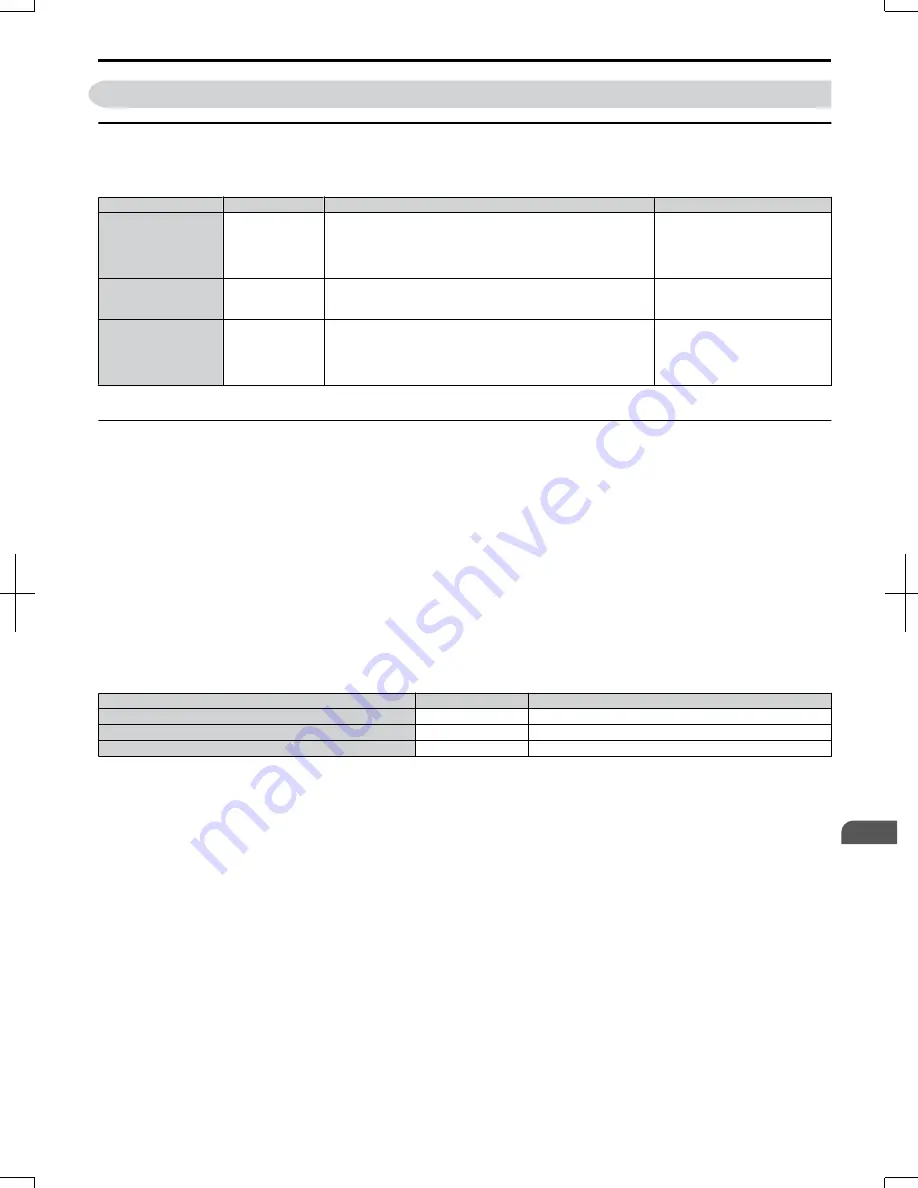
4.7 Auto-Tuning
u
Types of Auto-Tuning
There are three types of Auto-Tuning. Select the best type of Auto-Tuning for the application.
Refer to Auto-Tuning
Procedure on page 88
.
Type
Setting
Application Conditions and Benefits
Control Mode
Rotational
Auto-Tuning
for V/f Control
T1-01 = 3
• Assumes the motor can rotate during the Auto-Tuning process
• Improves torque compensation, slip compensation, energy
savings, and Speed Search performance
• Should be performed when Speed Estimation Type Speed
Search or Energy Saving is used in V/f Control
V/f Control
Rotational Auto-
Tuning
for OLV Control
T1-01 = 0
• Assumes the motor can rotate during the Auto-Tuning process
• Achieves high-performance motor control and should be
performed whenever Open Loop Vector Control is used
Open Loop Vector Control
Stationary Auto-
Tuning
for Line-to-Line
Resistance (V/f and
OLV Control)
T1-01 = 2
For use when:
• The motor cable exceeds 50 m
• The motor cable length has been modified after Auto-Tuning has
been previously performed
• When motor capacity and drive capacity differ
V/f Control, Open Loop Vector
Control
Note:
Auto-Tuning cannot be performed on permanent magnet motors (IPM, SPM, etc.).
u
Before Auto-Tuning the Drive
Check the items below before Auto-Tuning the drive.
n
Basic Auto-Tuning Preparations
• Auto-Tuning automatically determines the electrical characteristics of the motor. This is fundamentally different from
other types of Auto-Tuning features used in servo systems.
• Auto-Tuning requires the user to input data from the motor nameplate. Make sure the information written on the
nameplate is available before Auto-Tuning the drive.
• For best performance, be sure the drive input supply voltage equals or exceeds the motor rated voltage.
Note:
Performance can be enhanced by using a motor with a base voltage that is 20 V (40 V for 400 V class models) lower than the input supply
voltage. This may be of special importance when operating the motor above 90% of base speed, where high torque precision is required.
• Auto-Tuning is not possible with permanent magnet motors.
• To cancel Auto-Tuning, press the STOP key on the LED operator.
•
Table 4.19
describes digital input and output terminal status during Auto-Tuning.
Table 4.19 Digital Input and Output Operation During Auto-Tuning
Auto-Tuning Type
Digital Input
Digital Output
Rotational Auto-Tuning for V/f Control
Not available
Functions the same as during normal operation
Rotational Auto-Tuning for OLV Control
Not available
Functions the same as during normal operation
Stationary Auto-Tuning for Line-to-Line Resistance
Not available
Maintains the status at the start of Auto-Tuning
WARNING! Sudden Movement Hazard. Do not release the mechanical brake during stationary Auto-Tuning. Inadvertent brake release
may cause damage to equipment or injury to personnel. Ensure that the mechanical brake release circuit is not controlled by the drive
multi-function digital outputs.
Note:
It is recommended that Rotational Auto-Tuning is performed with the load disconnected. Failure to comply could result in improper drive
operation. If Rotational Auto-Tuning is performed for a motor coupled to a load, the motor constants will be inaccurate and the motor
may exhibit abnormal operation. Disconnect or decouple the motor from the load.
n
Notes on Rotational Auto-Tuning
• For optimal performance, Auto-Tuning should only be done with the motor uncoupled from the load for applications
requiring high performance over a wide speed range.
• If motor and load can not be uncoupled, the load should be lower than 30% of the rated load. Performing Rotational
Auto-Tuning with a higher load will set motor parameters incorrectly, and can cause irregular motor rotation.
• Ensure the motor-mounted brake is fully released if installed.
• Connected machinery should be allowed to rotate the motor.
n
Notes on Stationary Auto-Tuning for Terminal Resistance Only
• If the motor cable lead length has been significantly modified after Auto-Tuning has already been performed, perform
Stationary Auto-Tuning with the new cables.
• Perform when using motor cables longer than 50 m with V/f Control.
WARNING! Electrical Shock Hazard. When executing stationary Auto-Tuning for line-to-line resistance only, the motor does not rotate,
however, power is applied. Do not touch the motor until Auto-Tuning is completed. Failure to comply may result in injury from electrical
shock.
4.7 Auto-Tuning
SIEP C710606 20 OYMC AC Drive - V1000 User Manual
87
4
Start-Up Programming & Operation
7/16/2008-13:23
















































